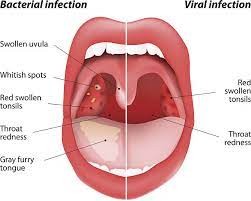Pharyngitis - Symptoms, Causes, Prevention and Treatment

What Is Pharyngitis?
Pharyngitis is a cough and sore throat, but can also
include lumps in the throat or swelling of the pharynx. It is a common
respiratory tract infection caused by a virus, usually adenovirus types 2 and
36. "Pharyngitis" is often shortened to "ph."
How Common Is Pharyngitis?
Adenovirus infections are the most common cause of
pharyngitis in older children and adolescents, while respiratory syncytial
virus (RSV) is the most common cause in infants and young children.
RSV infections can cause persistent cough and wheeze.
Additionally, bacteria such as Bordetella and Mycoplasma pneumonia can cause
upper respiratory illness in infants and young children. Pharyngitis usually
lasts for about a week.
What Are The Symptoms?
Symptoms include (but are not limited to) sore throat,
fever, headache, and loss of appetite. Symptoms usually appear two to three
weeks after the virus is contracted.
Signs of inflammation due to chronic infection or
repeated respiratory tract infections can include lumps in the throat or
swelling of the pharynx. Patients may also complain of hoarseness (an
accentuation of their normal voice).
When Should I Seek Medical Attention?
Although this condition is most common in children, it
can happen at any age. A doctor should be consulted if the pain lasts more than
2-3 days, if the throat is very red or swollen with white spots, or if there
are any lumps in the throat or swelling of the pharynx.
What Is The Treatment?
Antibiotics may not be necessary unless the patient is
sicker. Most cases of pharyngitis clear up on their own without antibiotics.
The primary treatments for patients are rest and
drinking fluids. Small sips of liquids such as water and warm chicken broth may
be helpful to loosen secretions and make swallowing easier. Larger sips of
fluids should only be taken when swallowing is not painful (which usually
occurs 7-10 days after infection).
What Causes It?
Viruses are always present in the air, so you're likely
to get pharyngitis when you breathe in viruses that invade your body through
your nose and mouth.
This can happen when there's too much smoke, dust, or
pollution nearby that contains these viruses. Viruses are also easily passed
from person to person through the air.
How Is It Prevented?
The best way to prevent pharyngitis is not to breathe
in airborne viruses, but this method is impossible.
By practising good hygiene and by getting vaccinations
you can help prevent catching respiratory infections like pharyngitis.
An open sore caused by pharyngitis should not be picked
at. If it is, it would increase the risk of infecting deeper tissues or causing
skin ulcers that may be infected with bacteria or fungus. The skin should be
cleansed with soap and water until the area heals or until there are no signs
of infection.
Treating the sore with antibiotics is unnecessary if
the patient's symptoms are mild or resolve on their own. Antibiotics are used
only in serious cases of pharyngitis with fever, difficulty swallowing, or
unexplained swelling of the neck.
It is not necessary to give antibiotics to infants
younger than 2 months old because they are born with good immunity against
colds and influenza viruses; these kids do not need medications for common
respiratory infections like pharyngitis.
What you can do for your child at home:
·
For infants younger than four months who develop
a fever and itchy nose, partially cover their nose with a clean wet cloth.
·
Give warm fluids (without sugar) that aid in
loosening secretions.
·
For babies who are not breastfed, give 1
milliliter of infant acetaminophen every 3 to 4 hours. If the fever continues
beyond 48 hours, have your doctor check your baby.
·
Hold babies upright rather than lying flat on
their backs, which increases swallowing difficulty.
·
Support the head with pillows when lying down to
sleep.
What Does It Feel Like? How Long Does It Last?
Children with pharyngitis usually have a sore throat
that feels scratchy or raw. They may have a low-grade fever, headaches, cough,
or other cold symptoms, and they may seem more tired than usual. Most cases
clear up in about 1 week without antibiotics.
